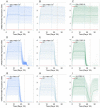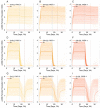Strategies to Mitigate Establishment under the Wolbachia Incompatible Insect Technique
- PMID: 35746601
- PMCID: PMC9229438
- DOI: 10.3390/v14061132
Strategies to Mitigate Establishment under the Wolbachia Incompatible Insect Technique
Abstract
The Incompatible Insect Technique (IIT) strategy involves the release of male mosquitoes infected with the bacterium Wolbachia. Regular releases of male Wolbachia-infected mosquitoes can lead to the suppression of mosquito populations, thereby reducing the risk of transmission of vector-borne diseases such as dengue. However, due to imperfect sex-sorting under IIT, fertile Wolbachia-infected female mosquitoes may potentially be unintentionally released into the environment, which may result in replacement and failure to suppress the mosquito populations. As such, mitigating Wolbachia establishment requires a combination of IIT with other strategies. We introduced a simple compartmental model to simulate ex-ante mosquito population dynamics subjected to a Wolbachia-IIT programme. In silico, we explored the risk of replacement, and strategies that could mitigate the establishment of the released Wolbachia strain in the mosquito population. Our results suggest that mitigation may be achieved through the application of a sterile insect technique. Our simulations indicate that these interventions do not override the intended wild type suppression of the IIT approach. These findings will inform policy makers of possible ways to mitigate the potential establishment of Wolbachia using the IIT population control strategy.
Keywords: Aedes aegypti; Incompatible Insect Technique (IIT); Sterile Insect Technique (SIT); Wolbachia; compartmental modelling; dengue; establishment; introgression; simulation.
Conflict of interest statement
The authors declare no conflict of interest.
Figures






References
-
- World Health Organization Vector-Borne Diseases Fact Sheet. 2017. [(accessed on 30 December 2021)]. Available online: https://www.who.int/news-room/fact-sheets/detail/vector-borne-
MeSH terms
LinkOut - more resources
Full Text Sources
Research Materials

